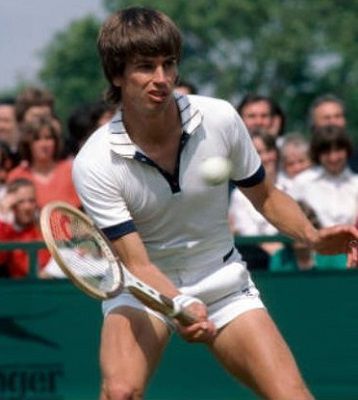Less than two weeks from Wimbledon, and the warm-ups were in full swing. The field divided into two combined men’s and women’s events: one in Nottingham, the other in Beckenham.
The 1973 Nottingham ladies’ draw boded well for the big event. Billie Jean King lived up to her top seed, sweeping the tournament without the loss of a set. In the final on June 16th, she defeated in-form home hope Virginia Wade, who had drubbed Chris Evert the day before.
King had watched Margaret Court dominate the circuit while she sat out with a stomach injury. Now she was riding a three-tournament, eleven-match win streak. She was well-rested, too. “I am feeling fitter at this stage,” she said, “than for quite a few Wimbledons past.”
The men’s action in Nottingham provided the surprises. Brit Roger Taylor, one of the best players present, lost in the first round. Mark Cox, another top Englishman, fell in the quarters. Jimmy Connors suffered the same fate as his love interest Chrissie, departed in the semis. Jimbo’s conqueror was another American, the oft-forgotten Erik van Dillen.
When van Dillen’s name came up, it was usually to do with his doubles prowess. Just 22 years old, he was already the veteran of two Davis Cup campaigns. He and partner Stan Smith lost a close match to the Romanians in the 1971 final. The next year, the American pair went 5-0. They saved their strongest performance of all for the hostile crowd in Bucharest, where they demolished Ilie Năstase and Ion Țiriac, 6-2, 6-0, 6-3. Many observers thought van Dillen was the best player on the court that day.
No one questioned van Dillen’s talent. He had been winning tournaments since he played 12-and-unders. The problem was consistency. One day he could outclass Smith and Năstase, or drop a 6-1, 6-0 wrecking ball on Arthur Ashe, as he did in February 1973. Then he would fail to put two good sets together for a month.
In Nottingham, van Dillen upset both Cliff Drysdale and Dick Stockton to reach the semi-finals. At that stage he encountered a “surprisingly quiet” Connors. Jimbo took the second set but the underdog retook the ascendancy with a comfortable three-set win. Van Dillen’s final opponent was another player with a two-handed backhand, the South African Frew McMillan. The American struggled with McMillan’s double-hander in the first set, but when it started going astray, van Dillen capitalized with his best game. The score: 3-6, 6-1, 6-1.
Naturally, he won the doubles, too.
Then he headed to Queen’s Club. He was entered in qualifying.
* * *
Down in Beckenham, two men tested the limits of a single tiebreak set. Wimbledon and other British tournaments adopted the first-to-seven tiebreak for the first time in 1973. Of course, they had to do things a little differently. Instead of holding the shootout at six games apiece, they would wait until eight-all. And the deciding set would be played the old-fashioned way, even if it took all week.
Soviet standout Alex Metreveli took the Beckenham title 6-3, 9-8(9). That’s a second set consisting of 16 games plus another 20 points. The challenger who pushed Metreveli to such extremes was gaining a reputation for turning routine victories into dogfights. The runner-up in question: Björn Borg. A week after his 17th birthday, playing just his third career grass tournament, the Swede made it clear he was more than just a dirtballer.
In the semis, Borg had dismissed the Australian Owen Davidson, a veteran with two grass-court titles in the last month. Davidson was suitably impressed. He said, “I cannot remember ever playing a better 17-year-old.”
* * *
Borg, Metreveli, and van Dillen would be three dark horses to watch at Wimbledon–if there were a men’s tournament worth the name. Players and federations had made no progress toward resolving the status of Niki Pilić, the Yugoslavian player banned by his national body, sanctioned by the ILTF, and now heartily backed by the players’ union. Nearly 100 players were ready to boycott.
On June 16th, Pilic and Arthur Ashe headed out to the All-England Club, hoping to get some practice in. They didn’t make it past the door. “I turned them off,” said the club secretary, “because this is a private club and they are not members.”
* * *
This post is part of my series about the 1973 season, Battles, Boycotts, and Breakouts. Keep up with the project by checking the TennisAbstract.com front page, which shows an up-to-date Table of Contents after I post each installment.
You can also subscribe to the blog to receive each new post by email:
